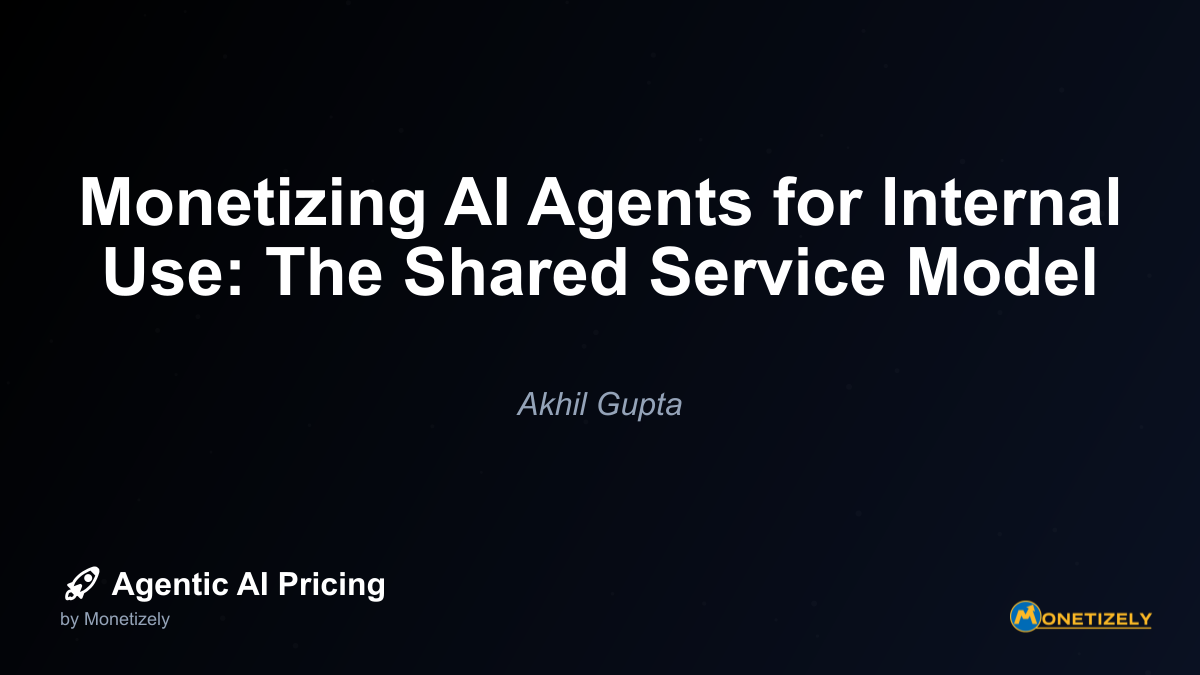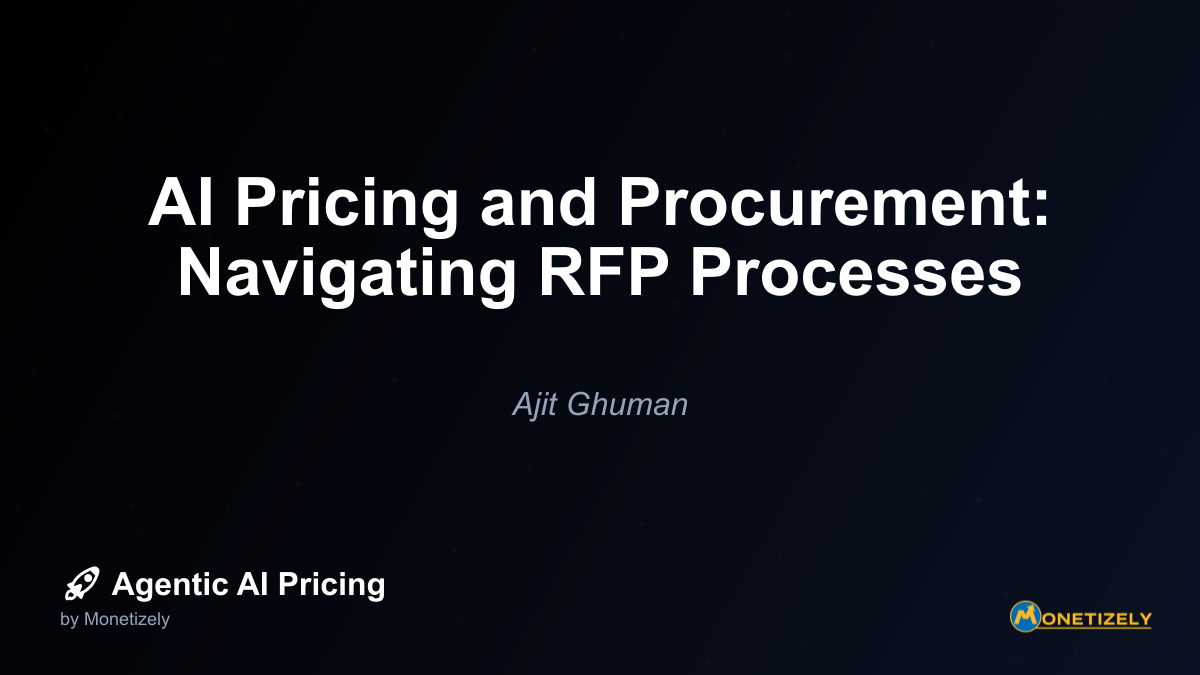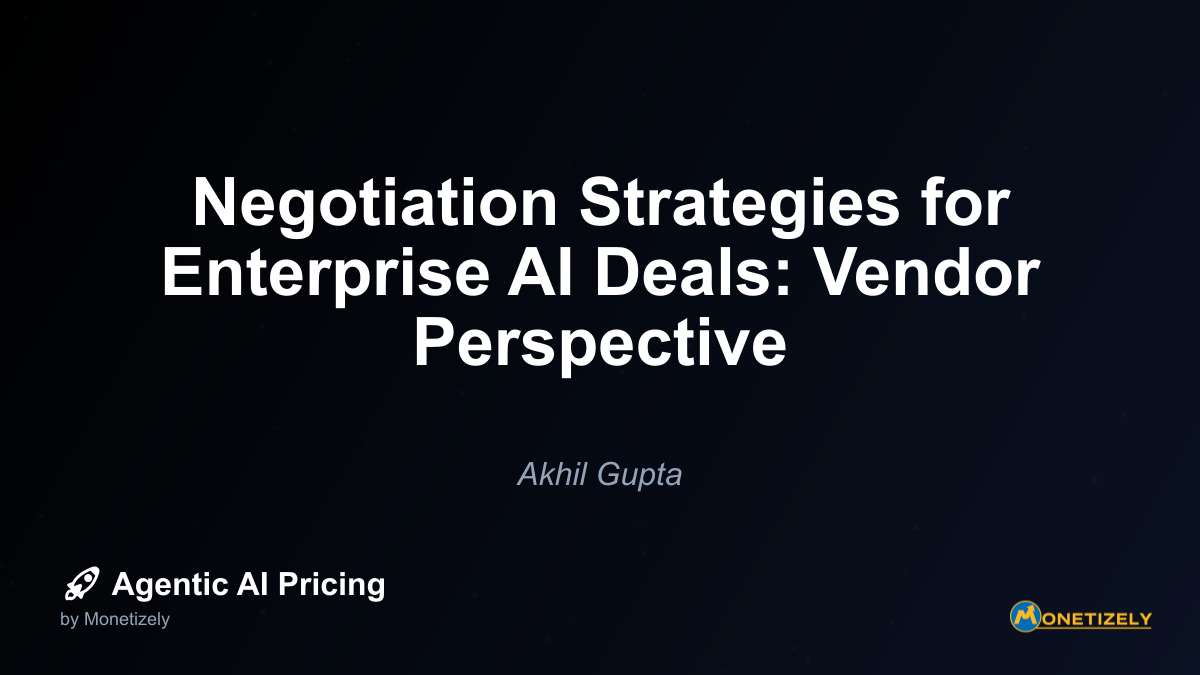· Akhil Gupta · Enterprise · 11 min read
Monetizing AI Agents for Internal Use: The Shared Service Model
AI and SaaS Pricing Masterclass
Learn the art of strategic pricing directly from industry experts. Our comprehensive course provides frameworks and methodologies for optimizing your pricing strategy in the evolving AI landscape. Earn a professional certification that can be imported directly to your LinkedIn profile.

The enterprise landscape is rapidly evolving as organizations seek to maximize the value of their AI investments while maintaining cost efficiency. The shared service model for AI capabilities represents a strategic approach to internal monetization, enabling businesses to allocate resources effectively, drive accountability, and optimize the return on AI investments across departments. This comprehensive guide explores how enterprises can implement chargeback systems for AI capabilities shared across departments, providing a roadmap for organizations looking to transform AI from a cost center to a value-generating shared service.
The Strategic Imperative for Internal AI Monetization
As enterprises scale their AI investments, the need for structured approaches to resource allocation becomes increasingly critical. According to recent market data, enterprise LLM (large language model) budgets are expected to grow by approximately 75% in 2025, reflecting the rapid expansion of AI adoption across business functions. This growth necessitates sophisticated mechanisms for tracking, allocating, and optimizing AI expenditures.
Internal monetization of AI capabilities through shared service models addresses several strategic imperatives:
- Cost visibility and control: Providing transparency into AI consumption and associated costs
- Resource optimization: Ensuring AI resources are allocated to high-value use cases
- Accountability: Creating incentives for responsible AI usage across business units
- Value measurement: Establishing frameworks to quantify AI’s business impact
- Scalability: Supporting sustainable AI growth aligned with business outcomes
“The transition from viewing AI as purely an IT overhead expense to treating it as a strategic shared service requires robust internal pricing mechanisms,” notes Dr. Elaine Chen, Chief AI Economist at Enterprise AI Strategies. “Organizations that implement effective chargeback systems can drive 30-40% more value from their AI investments by aligning consumption with business outcomes.”
Understanding the Shared Service Model for AI Capabilities
Definition and Core Components
The shared service model for AI represents a centralized approach to providing AI capabilities across an organization. Rather than each department building and maintaining separate AI infrastructure and expertise, a central AI shared service function delivers these capabilities while implementing mechanisms to allocate costs based on usage or value.
Key components of an AI shared service model include:
- Centralized AI infrastructure and expertise: Consolidated AI platforms, models, and technical talent
- Service catalog: Defined AI capabilities available to business units
- Governance framework: Policies for access, usage, and compliance
- Consumption tracking: Mechanisms to measure AI usage by department
- Chargeback system: Methods to allocate costs to consuming departments
- Performance metrics: KPIs to evaluate service effectiveness
Evolution from Cost Center to Strategic Service
Traditionally, enterprise AI initiatives have been funded as central IT costs, with little visibility into departmental consumption or value creation. The shared service model represents an evolution toward treating AI as a strategic service with clear accountability for both providers and consumers.
This evolution typically progresses through several stages:
- Centralized cost center: AI costs absorbed by IT with limited visibility
- Showback model: Usage tracked and reported without financial consequences
- Basic chargeback: Simple allocation of costs based on consumption metrics
- Value-based chargeback: Sophisticated allocation incorporating business outcomes
- Internal marketplace: Self-service AI capabilities with dynamic pricing
“Leading organizations are rapidly moving beyond basic showback models to implement sophisticated chargeback systems that balance usage-based metrics with outcome-based value creation,” explains Morgan Zhang, Director of AI Economics at Global Enterprise Solutions. “This shift fundamentally changes how departments perceive and consume AI resources.”
Market Trends in Internal AI Monetization (2023-2025)
The landscape of internal AI monetization is evolving rapidly, with several key trends emerging:
Increasing Budget Allocation and Accountability
Enterprises are allocating significant budgets toward AI, especially generative AI. According to Andreessen Horowitz’s 2025 Enterprise AI Survey, tech-forward companies are evolving from internal-only use cases to customer-facing AI platforms that drive larger spend and revenue impact. This expansion requires greater budget visibility and control mechanisms.
Transition from Experimentation to Scaled Adoption
Organizations are moving beyond AI experimentation to scaled adoption across product development, risk management, and customer-facing scenarios. McKinsey’s 2023 State of AI report indicates that 55% of organizations are now using AI in at least one business function, up from 20% in 2017. This scaling necessitates more sophisticated approaches to resource allocation.
Emergence of Outcome-Based Pricing Models
While usage-based charging remains common, outcome-based pricing models—where internal payment is linked to AI-empowered business outcomes—are gaining traction. These models better align AI consumption with value creation but require more sophisticated measurement frameworks.
Centralized AI Provisioning with Distributed Consumption
The prevailing model involves centralized AI infrastructure and expertise combined with distributed consumption across business units. This approach balances economies of scale with business unit autonomy, requiring robust chargeback mechanisms to maintain equilibrium.
Building the Business Case for Internal AI Monetization
Implementing a chargeback system for shared AI services requires a compelling business case that addresses both financial and strategic objectives.
Financial Benefits
- Cost transparency: Providing visibility into AI consumption and associated costs
- Resource optimization: Reducing waste by incentivizing efficient usage
- Budget predictability: Enabling better forecasting of AI expenditures
- Investment prioritization: Directing resources to highest-value use cases
- ROI measurement: Creating frameworks to quantify return on AI investments
Strategic Benefits
- Accountability: Establishing clear ownership for AI consumption and outcomes
- Innovation incentives: Encouraging experimentation while maintaining cost discipline
- Value alignment: Connecting AI investments to business outcomes
- Strategic positioning: Elevating AI from technical capability to business enabler
- Cultural transformation: Fostering a data-driven, outcome-focused organization
“The most compelling aspect of a well-designed chargeback system isn’t cost recovery—it’s the behavioral change it drives,” notes Dr. Sarah Patel, Chief Digital Economist at Enterprise AI Advisory. “When departments see AI as a service with tangible costs rather than a free resource, they become much more intentional about how they leverage it.”
Designing Effective Chargeback Models for AI Services
Understanding Different Pricing Approaches
Enterprises typically implement one or more of the following pricing models for internal AI services:
1. Usage-Based Pricing
This model charges departments based on consumption metrics such as:
- API calls or model invocations
- Compute resources consumed (GPU hours, CPU time)
- Data processed or tokens generated
- Storage utilized
Advantages: Direct correlation between usage and cost; encourages efficiency Challenges: May discourage experimentation; requires robust usage tracking
2. Subscription-Based Pricing
This approach charges a fixed fee for access to AI services, typically:
- Monthly/quarterly/annual subscription
- Tiered access levels with different capabilities
- User-based licensing (per seat)
Advantages: Predictable costs; simpler administration Challenges: May not reflect actual usage; potential for overprovisioning
3. Outcome-Based Pricing
This sophisticated model ties charges to business outcomes enabled by AI:
- Cost savings achieved
- Revenue generated
- Productivity improvements
- Quality enhancements
Advantages: Directly links AI to business value; aligns incentives Challenges: Complex to measure and attribute; requires mature tracking systems
4. Hybrid Pricing Models
Many organizations implement hybrid approaches combining elements of the above:
- Base subscription plus usage-based overages
- Core services under subscription with premium features priced separately
- Foundational access plus outcome-based incentives
Advantages: Balances predictability with accountability; flexible Challenges: More complex to administer; requires sophisticated systems
Cost Allocation Strategies
Effective cost allocation requires careful consideration of both technical and business factors:
Direct Cost Allocation
- Infrastructure costs: Cloud computing, specialized hardware, storage
- Software licensing: Model licenses, platform fees, development tools
- Data costs: Acquisition, storage, preparation, labeling
- Operational costs: Monitoring, maintenance, security
Indirect Cost Allocation
- Personnel: AI/ML engineers, data scientists, operations staff
- Training and development: Model training, fine-tuning, optimization
- Governance: Compliance, risk management, ethics review
- Innovation: Research, experimentation, continuous improvement
“The art of cost allocation lies in balancing simplicity with fairness,” explains Financial Systems Architect Jennifer Wu. “Too simple, and you risk misallocating costs; too complex, and the system becomes unmanageable. The key is identifying the 3-5 metrics that most accurately reflect departmental consumption and value creation.”
Implementation Framework for AI Chargeback Systems
Phase 1: Assessment and Planning
Current state analysis
- Inventory existing AI capabilities and infrastructure
- Map current consumption patterns across departments
- Identify key stakeholders and decision-makers
- Assess organizational readiness for chargeback model
Business requirements definition
- Define objectives for the chargeback system
- Identify key metrics for tracking and allocation
- Establish governance framework and policies
- Determine reporting and analytics requirements
Model selection and design
- Choose appropriate pricing model(s)
- Define service catalog and pricing structure
- Design allocation methodologies
- Develop financial processes and controls
Phase 2: Technical Implementation
Infrastructure setup
- Implement usage tracking mechanisms
- Configure monitoring and metering tools
- Integrate with financial systems
- Establish data pipelines for metrics collection
System integration
- Connect AI platforms with billing systems
- Implement authentication and authorization
- Develop APIs for service consumption
- Create dashboards and reporting interfaces
Testing and validation
- Validate accuracy of usage tracking
- Test allocation calculations
- Verify integration with financial systems
- Conduct user acceptance testing
Phase 3: Organizational Rollout
Change management
- Develop communication strategy
- Conduct stakeholder education and training
- Establish support processes
- Address concerns and resistance
Pilot implementation
- Select initial departments for rollout
- Implement in controlled environment
- Gather feedback and refine approach
- Document lessons learned
Full deployment
- Expand to all departments
- Transition from parallel to primary system
- Implement ongoing governance
- Establish continuous improvement process
“The technical implementation is often the easiest part,” notes Enterprise AI Transformation Lead Michael Chen. “The real challenge lies in organizational change management—helping departments understand the value proposition and adapt their behaviors accordingly.”
Technical Architecture for AI Chargeback Systems
Core Components
A comprehensive AI chargeback system typically includes the following components:
Usage metering layer
- API gateways with usage tracking
- Compute resource monitoring
- Storage and data transfer measurement
- User activity tracking
Data collection and processing
- Usage data aggregation
- Transformation and normalization
- Historical data storage
- Real-time processing capabilities
Allocation engine
- Cost distribution algorithms
- Business rule implementation
- Exception handling
- Reconciliation mechanisms
Integration interfaces
- Financial system connectors
- Identity and access management
- Service catalog integration
- Reporting and analytics tools
User interfaces
- Administrative dashboards
- Department-level reporting
- Service consumption portals
- Budget management tools
Technology Enablers
Several technologies and platforms can support the implementation of AI chargeback systems:
Cloud provider tools
- Azure Cost Management
- AWS Cost Explorer
- Google Cloud Billing
- IBM Cloud Cost and Asset Management
Observability platforms
- Datadog
- New Relic
- Dynatrace
- Splunk
FinOps platforms
- CloudHealth
- Apptio
- Cloudability
- VMware Aria Cost
Custom solutions
- Internal billing systems
- Custom dashboards and reports
- Specialized allocation engines
- Integration middleware
“The ideal technical architecture provides granular visibility into AI consumption while abstracting complexity from end users,” explains Enterprise AI Platform Architect Ravi Mehta. “Departments should see clear, actionable information about their usage and costs without needing to understand the underlying technical details.”
Case Studies: Successful Implementation of AI Chargeback Systems
Case Study 1: Global Financial Services Firm
Challenge: A leading financial services organization struggled with rapidly increasing AI costs across its trading, risk management, and customer service functions, with limited visibility into which departments were driving consumption.
Approach:
- Implemented a hybrid chargeback model combining base subscription with usage-based components
- Deployed granular tracking of API calls, compute resources, and data processing
- Integrated with existing financial systems for automated allocation
- Established quarterly review process to refine allocation methodology
Results:
- 27% reduction in overall AI costs within first year
- Improved alignment between consumption and business value
- Enhanced ability to prioritize AI investments
- Greater accountability for AI usage across business units
“The transparency created by our chargeback system completely transformed how we think about AI,” notes the firm’s CTO. “Departments now approach AI as a strategic investment rather than a free resource, leading to more thoughtful implementation and clearer business cases.”
Case Study 2: Multinational Healthcare Provider
Challenge: A healthcare provider with operations across 12 countries needed to allocate AI costs for diagnostic assistance, administrative automation, and research applications while maintaining compliance with varying regulatory requirements.
Approach:
- Developed outcome-based pricing model tied to specific healthcare metrics
- Implemented sophisticated tracking of AI contribution to diagnosis accuracy, administrative efficiency, and research outcomes
- Created governance framework balancing central control with local autonomy
- Designed compliance-first architecture with regional data segregation
Results:
- Successfully allocated 85% of AI costs based on measurable outcomes
- Improved diagnostic accuracy by 18% through incentivized AI adoption
- Reduced administrative costs by 32% through optimized AI implementation
- Maintained regulatory compliance across all jurisdictions
“By tying our internal pricing to healthcare outcomes rather than technical metrics, we shifted the conversation from ‘How much AI are we consuming?’ to ‘How is AI improving patient care?’” explains the organization’s Chief Digital Officer.
Case Study 3: Manufacturing Conglomerate
Challenge: A global manufacturing organization needed to allocate AI costs across product design, supply chain optimization, quality control, and predictive maintenance functions while encouraging innovation.
Approach:
- Implemented tiered subscription model with innovation credits
- Created internal marketplace for AI capabilities with transparent pricing
- Established cross-functional governance committee to oversee allocation
- Developed ROI measurement framework specific to manufacturing contexts
Results:
- 40% increase in AI-driven innovation projects
- 22% improvement in supply chain efficiency
- 35% reduction in quality control costs
- Clear visibility into AI value creation across business units
“The innovation credits within our chargeback system were transformative,” notes the VP of Digital Manufacturing. “Departments could experiment with new AI applications without immediate cost pressure, but with a clear path to measuring value once implemented.”
Governance Models for AI Shared Services
Effective governance is essential for successful implementation of AI shared service models. Key elements include:
Organizational Structure
Centralized governance
- AI Center of Excellence (CoE) with oversight responsibility
- Enterprise-wide policies and standards
- Centralized approval processes
- Consolidated reporting and analytics
Federated governance
- Central framework with local implementation
- Business unit representation in governance bodies
- Delegated authority with accountability
- Balanced decision-making processes
Hybrid governance
- Centralized infrastructure and platform governance
- Decentralized application and use case governance
- Shared responsibility for outcomes
- Collaborative decision-making processes
Governance Bodies
AI Executive Steering Committee
- Senior leadership representation
- Strategic direction and investment decisions
- Policy approval and oversight
- Cross-functional alignment
AI Shared Service Council
- Business unit representatives
- Service level agreement management
- Pricing and allocation decisions
- Performance monitoring and improvement
AI Ethics and Compliance Committee
- Risk and compliance expertise
- Ethical guidelines and standards
- Regulatory compliance oversight
- Responsible AI principles
“Effective governance requires balancing central control with business unit autonomy,” explains Dr. Rebecca Martinez, Enterprise AI Governance Expert. “Too much centralization stifles innovation; too little leads to inefficiency and inconsistency. The key is creating clear guardrails while empowering departments to drive value within them.”
Measuring Success: KPIs for AI Shared Service Models
Comprehensive measurement frameworks should include metrics across multiple dimensions:
Financial Metrics
Cost efficiency
- Total cost of AI ownership
- Cost per transaction or service
- Cost allocation accuracy
- Budget variance
Value creation
- Return on AI investment
- Cost savings achieved
- Revenue generated
- Productivity improvements
Operational Metrics
Service performance
- System availability and reliability
- Response time and latency
- Error rates and quality
- Service level agreement compliance
Consumption patterns
- Usage by department and function
- Peak vs. average consumption
- Utilization rates
- Adoption metrics
Strategic Metrics
- Innovation and growth
- New AI use cases developed
- Expansion of AI capabilities
- Competitive advantage create
Co-Founder & COO
Akhil is an Engineering leader with over 16+ years of experience in building, managing and scaling web-scale, high throughput enterprise applications and teams. He has worked with and led technology teams at FabAlley, BuildSupply and Healthians. He is a graduate from Delhi College of Engineering and UC Berkeley certified CTO.
Pricing Strategy Audit
Let our experts analyze your current pricing strategy and identify opportunities for improvement. Our data-driven assessment will help you unlock untapped revenue potential and optimize your AI pricing approach.




